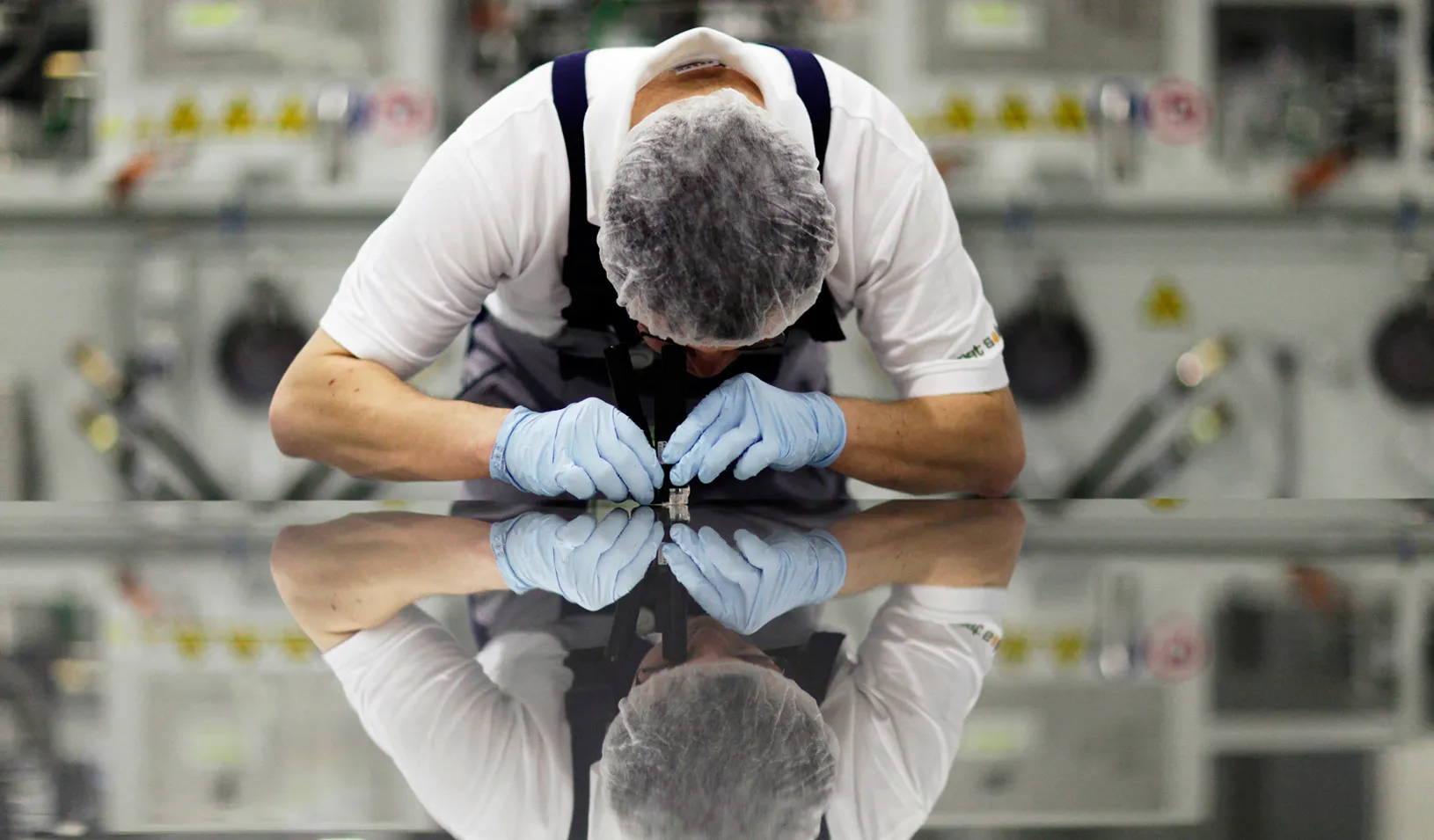Chris Tonetti: An Economist Shows How Imitation Can Sometimes Beat Innovation
Technical innovation makes more sense for some countries and companies than others.
July 23, 2014
A worker checks a photovoltaic module in Germany. | Reuters/Hannibal Hanschke
In economic debates, it is about as close to a mantra as you can get: Innovation is good, and faster innovation is even better. You can never have too much of it.
The World Bank, in a recent report, bemoaned what it called Europe’s “innovation deficit” and questioned whether Europe had “fundamental flaws in its economic environment” that were making it a permanent laggard behind the United States.
But there may be another side to the story. Investing in imitation can have big payoffs for economic growth, and sometimes even bigger payoffs than investing in innovation.
A new paper coauthored by Chris Tonetti, a macroeconomist at Stanford Graduate School of Business, shows that some countries are being entirely rational by tilting more toward adopting technology than developing it themselves. In a separate paper, Tonetti argues that the same is true at the company level: There are only a few Googles or Oracles in the world, but there are thousands upon thousands of companies that can generate big aggregate gains by using the innovations from the pioneers.
“If America is willing to invest all this energy and expense into innovation, and European countries can get the benefits a bit later, that might be the optimal strategy for them,” says Tonetti. “Investing more in innovation isn’t necessarily the right strategy for everyone.” Contrary to conventional wisdom, Tonetti and his coauthors say, a country’s prosperity doesn’t have to fall further behind just because it isn’t at the frontier of innovation. European incomes may be lower than incomes in the United States, but Europe’s prosperity can be stable. The gap between European incomes and the United States doesn’t have to widen, they say.
Working with Jess Benhabib of New York University and Jesse Perla at the University of British Columbia, Tonetti has developed a model for how countries can think through the right balance between imitation and innovation.
They call it the “productivity equilibrium,” and say it can vary widely between nations. “It’s not one-size-fits-all,” Tonetti says.
The researchers are not saying that more innovation is bad for society as a whole. For the public, innovation is almost always a win. But “private benefits” — such as the profits that accrue to an innovator — are usually smaller because innovation leaks out to the public in all sorts of ways. For a company, or even a government, those private returns from investment in innovation can be smaller than the returns from an investment in imitation.
Economic Growth from Imitation
One key issue is a nation’s efficiency in technology diffusion — actually putting innovations to practical use. That can depend on a host of factors, from a nation’s political institutions to its education levels and infrastructure. In general, the further a country lags behind the “innovation frontier,” the bigger the returns from imitation over innovation.
“The returns to imitation depend on how far behind you are from the innovation frontier,’’ Tonetti says. “If you are way behind, the returns are very high. As you get closer to the frontier, the returns shrink because eventually there’s nobody left to imitate. That’s when innovating becomes more attractive.”
There are some exceptions to that rule, the researchers caution. Some nations are so far behind that they can’t even be good imitators. For them, there is no “productivity equilibrium.” They just fall further and further behind.
But many fast-growing nations have evolved from being almost pure imitators to being technology producers in their own right. Japan followed that path after World War II, as did South Korea a decade or so later. Today, China appears on a similar course.
Reducing barriers to trade can spur the spread of innovation. If a country opens itself to foreign imports, its domestic companies are likely to come under pressure from more sophisticated competitors. That’s disruptive, but the competition can also push the domestic companies to upgrade technologies by imitating domestic or foreign rivals. That can ultimately make them more productive in their own right.
When to Hang Back Slightly
“The frontier countries act as a locomotive, pulling the other countries behind them,’’ says Tonetti.
For most European nations, which are close to the frontier, the right balance may well be to hang slightly behind the innovation leader. Europe produces innovation, of course, but it doesn’t invest in it with the same intensity as the United States. That may be OK, Tonetti suggests. Europeans can still reap substantial productivity growth by implementing technology that originated elsewhere.
In a separate paper, Tonetti and Perla develop a refreshingly unconventional model for how corporations can balance imitation versus innovation. Policy makers tend to focus on fostering cutting-edge companies that can grow at blinding rates and revolutionize entire industries.
But to generate more aggregate economic growth, Tonetti and Perla argue that it may be smarter to look at modest improvements in the legions of relatively inefficient old-school companies. There are only a few tech pioneers, but there are thousands of other companies that can reap significant increases in productivity at low cost by adopting technology from the pioneers.
“The least productive agents in the economy can be vital in generating growth by spurring technology diffusion,” the researchers write. “There are potentially enormous gains in aggregate output from marginally increasing the productivity of less productive agents.”
The World Bank report on Europe’s “innovation deficit” suggests that this is what many European companies have been doing for decades. “Europe’s most successful companies seem to grow by doing what they are already doing — but better,’’ the World Bank economists wrote.
It may not be a formula for the United States, but Tonetti suggests that it may well make sense for Europe.
Christopher Tonetti is assistant professor of economics at Stanford Graduate School of Business.
For media inquiries, visit the Newsroom.
Explore More

When Is It Too Late to Give Up Control of Your Finances?

Recessions Are Painful, but Stagnant Growth Could Prove More Challenging



